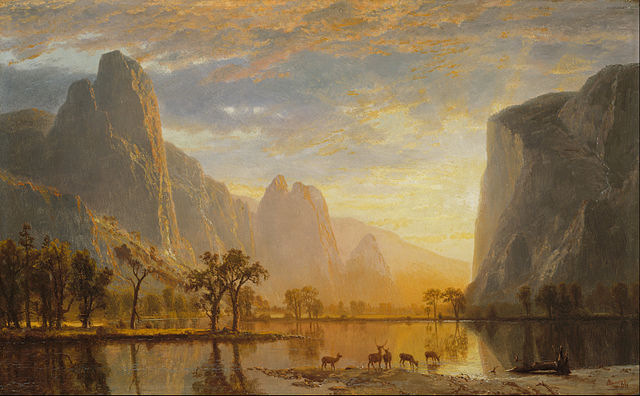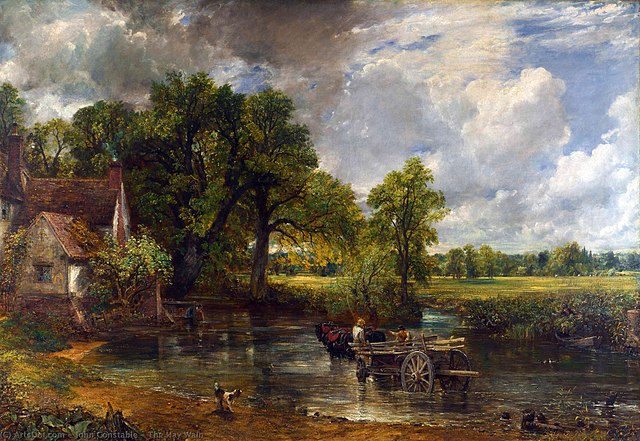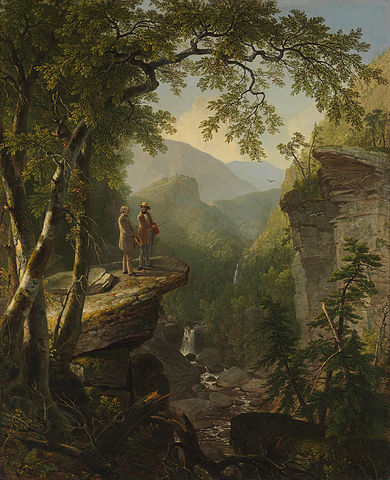Rivers have served as sources of life for people throughout thousands of years. Some of the greatest cities on Earth have been established alongside major rivers that bring in trade, food, and a number of other resources that are essential for the livelihood of a civilization.
Artists often recognize the pivotal role that rivers play in our ability to thrive and many have created paintings depicting our relationship to rivers and how they are connected to the subsistence of human life.
In this article, we’ll examine some of the most famous river paintings ever created and discuss the artists behind the work, as well as their motivations for producing them.
Famous River Paintings
1. The Fighting Temeraire, tugged to her last berth to be broken up – J. M. W. Turner

J. M. W. Turner is remembered as one of the most prolific English artists in recent history.
He is considered to be one of the greatest landscape and maritime artists who was part of the Romanticism movement that took place near the end of the 18th century and the beginning decades of the 1800’s. Many of Turner’s most well-known works relate to the sea or rivers in some way.
One of his greatest paintings is titled The Fighting Temeraire, tugged to her last berth to be broken up and was completed in 1839.
This work focuses on one of the British Navy’s famed warships that helped win pivotal battles during the war against Spain and France during the Napoleanic era. The Temeraire is said to have played a major role in the success of a particular engagement at the Battle of Trafalgar.
Turner’s painting is symbolic of the transition that was occurring in naval and maritime vessels after the end of the 18th century. The once-mighty Temeraire is being towed along the Thames River out to sea by a small, unattractive tugboat that was steam-powered.
The majestic warship is fading into the horizon as the setting sun relates the fact that this style of ship was now obsolete thanks to steam engine vessels becoming more popular.
2. The Oxbow – Thomas Cole

Thomas Cole was an American artist during the early 19th century who gained notoriety as a talented landscape artist. He is the founder of the famous Hudson River School, which was a popular movement that focused on nature and landscape paintings that were heavily influenced by the Romantic style of painting.
One of his most famous paintings is titled The Oxbow and features a scene depicting the untamed wilderness that drew in many Americans during the late 18th and early 19th centuries in a portion of what is now Connecticut.
Completed in 1836, this painting was a classic representation of a Hudson River School work in that it depicts a dichotomy that existed at the time between the portions of the American continent that were settled and those that were still mostly untouched by European influence.
The painting presents a beautiful view from a mountain overlooking the Connecticut River in which the viewer sees—on the right—a section of cleared, well-kept land with fields, cultivated lands and farm animals.
The left side portrays a wild, rugged landscape that is covered by an approaching storm and dark clouds. This contrast between the two seems to represent the order and civilization that settlers bring with them and the savage nature of the wild.
3. Valley of the Yosemite – Albert Bierstadt

Albert Bierstadt was another member of the Hudson River School movement whose career spanned a few decades toward the latter portion of the 19th century.
He is arguably the greatest landscape painter in American history, although he was born in Germany and his family immigrated to the United States when he was a year old.
One of Bierstadt’s most celebrated works is a depiction of the majestic Yosemite valley where the Merced River calmly flows through a section bordered by giant granite cliff faces. The painting is titled Valley of the Yosemite and was done in 1864 when settlers and others were finally starting to create homes in the area.
The Yosemite area is considered to be one of the most rugged and untamed sections of wilderness in the North American continent, but Bierstadt’s depiction of the famous valley gives the viewer a sense of tranquility and awe.
The artist skillfully portrayed the sunlight playing across the river, as well as the mountains on either side. The sun is visible in the far background while its glow is cast on the towering peaks that line both sides of the Merced River.
4. The Hay Wain – John Constable

Among English landscape artists from the early 19th century, few are more famous than John Constable. He is best-known for his works depicting stunning views of England’s countryside along with dark gray clouds overhead in the sky.
Constable often created paintings that portrayed some of the major rivers in England, including one of his most celebrated and iconic works depicting a scene on the River Stour.
The painting is titled The Hay Wain and focuses on a setting in which a farmer and three horses are seen pulling a hay-filled wagon, or hay wain, across the river to a small cottage home on the other side.
Completed in 1821, Constable’s work is believed to be one of the most iconic landscape paintings from the Romantic era that features a scene from rural England.
In the painting, the viewer sees the farmer and his wagon headed toward Willy Lott’s cottage, which is an actual house that still stands in Suffolk, England and also appears in several works done by Constable.
5. Washington Crossing the Delaware – Emanuel Leutze

Emanuel Leutze was another German-born artist that immigrated to America during the early 19th century. He focused his efforts on creating historic works that often were in the form of portraits or large paintings of notable battles and other events. One of Leutze’s paintings is considered to be among the most iconic works pertaining to American history.
The painting is titled Washington Crossing the Delaware and was completed in 1851, roughly 75 years after the event occurred. This work was done to commemorate the famous maneuver that led to the American forces being victorious over the British as Washington would lead his troops across the Delaware River on Christmas night and into the next morning to defeat Hessian forces that were stationed in Trenton, New Jersey.
The painting is one that depicts a heroic George Washington standing on the prow of the small boat looking toward the shore as they row across the icy river. Lieutenant James Monroe is standing behind him holding the American flag.
While this might be a stirring scene for many who adore the painting, historians and anyone familiar with small vessels will attest that the boat would have certainly tipped over if Washington and Monroe had actually stood up in such a heavily-loaded boat.
6. La Grenouillère – Pierre-Auguste Renoir

Pierre-Auguste Renoir is considered to be one of the most prominent members of the Impressionist movement and he is often credited with helping to develop it during the mid-1800’s. The French artist is part of a family of actors, filmmakers and artists and many of his works are among the most celebrated paintings of the Impressionist style.
One of Renoir’s most memorable paintings is titled La Grenouillère and depicts a scene on the Seine River that has since become one of the more famous river paintings of the movement. Completed in 1869, this work depicts a group of people gathered on a small island, or camembert, in the middle of the Seine.
Also Read: Famous Paintings of Parks
This painting features the characteristic brushwork that Renoir was known for and is a classic example of an Impressionist work in many ways. Critics and historians point to this painting as one of the earliest Impressionist works that helped spark the movement as a whole.
7. Bathers by a River – Henri Matisse

Henri Matisse is one of the most famous painters of the late 19th and early 20th centuries who created works in a few different art styles, including Impressionism and Fauvism. He is known for his distinct use of color, as well as creative compositions.
Matisse is known to have produced many paintings depicting nude bathers near water and many of his most famous works often celebrate human form.
One of his most well-known paintings is titled Bathers by a River. This work was completed in 1917 and portrays four nude figures bathing in a river. The work is considered to be done in the Fauvism style, which had a heavy emphasis on colors, as well as bold outlines.
8. Kaaterskill Falls – Thomas Cole

Another one of Thomas Cole’s famous river paintings was done with a focus on a well-known waterfall located in the Catskill Mountains of New York. Cole often produced works that depicted landscape art in a truly unique fashion, with this particular painting being one of them. The waterfall is made up of two different cascades, one directly above the other.
The painting is titled Kaaterskill Falls and was done in 1826 when Cole was still quite young. Instead of the usual view from below the waterfall, Cole painted this scene from the perspective of being inside the upper waterfall.
This waterfall paintings location is a major tourist attraction and is part of Spruce Creek, which runs through most of the eastern Catskill mountains.
9. Kindred Spirits – Asher Brown Durand

Asher Brown Durand was another member of the Hudson River School who was known for his ability to create highly-realistic scenes that often featured a vast expansive view. He was an American painter born in 1796 and was very well-known to some of the more prominent artists from the Hudson River School movement.
One of Durand’s most celebrated paintings is titled Kindred Spirits. This work was done in 1849 and critics believe it was created to commemorate Durand’s two close friends and contemporaries, Thomas Cole and William Cullen Bryant.
When this painting was done, Cole had died just one year earlier of a lung condition at the age of 47. The scene depicts the two artists standing together on a rocky outcropping that overlooks a small stream running below.
10. River Landscape with Ferry – Salomon van Ruysdael

Salomon van Ruysdael is one of the lesser-known painters from the 17th century who was a prolific landscape artist. He was part of an era that critics and historians refer to as the Dutch Golden Age and many of his paintings were done according to the Baroque style that was popular during his lifetime in Europe.
In 1649, Ruysdael created a painting titled River Landscape with Ferry, which featured a beautiful scene that is believed to be along the Rhine River.
There is a castle that is seen in the background, but historians note that it does not appear to be an image of any real structures known to have existed along the Rhine during this time period.

